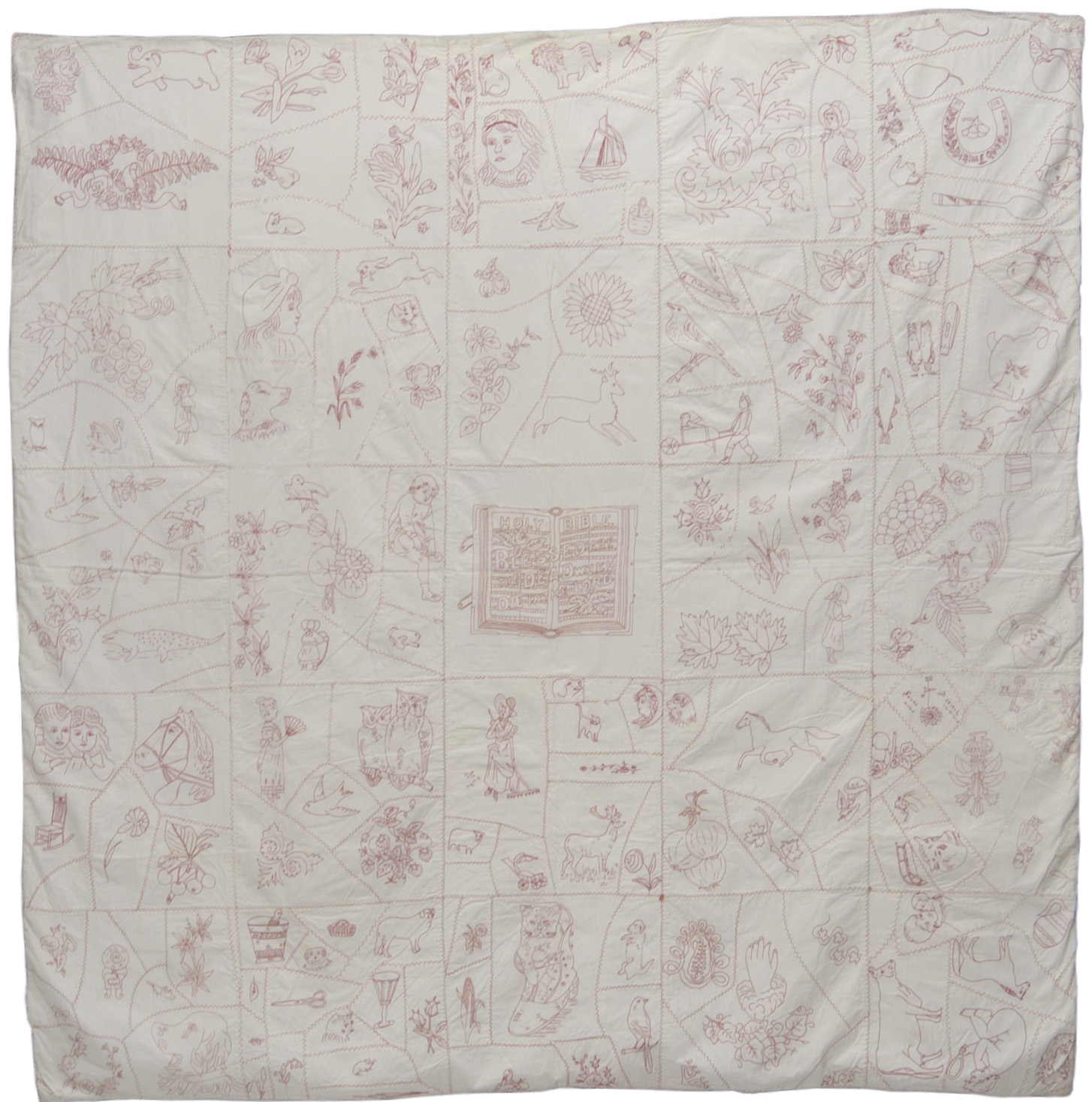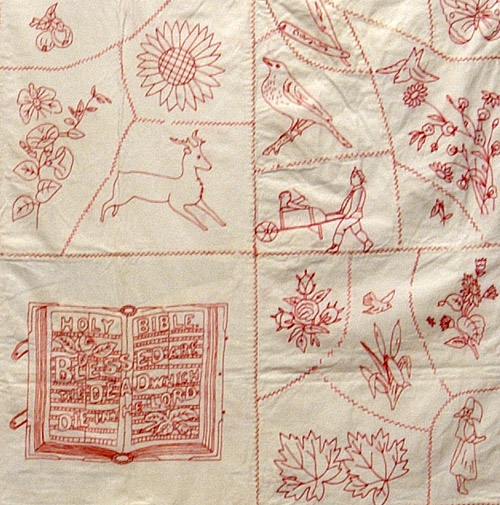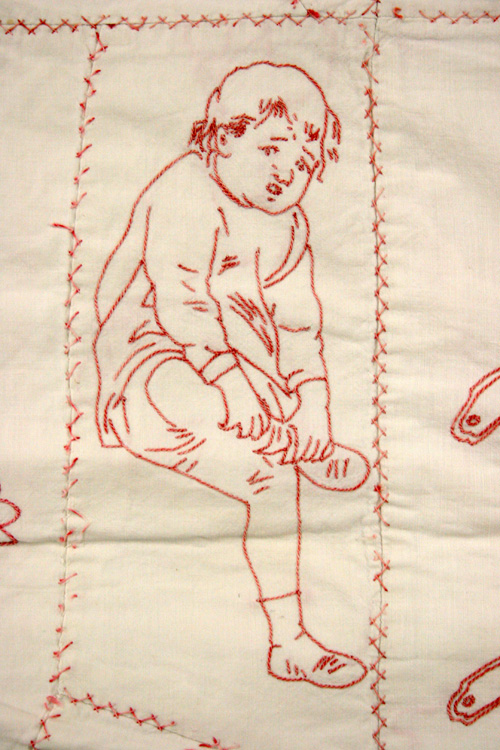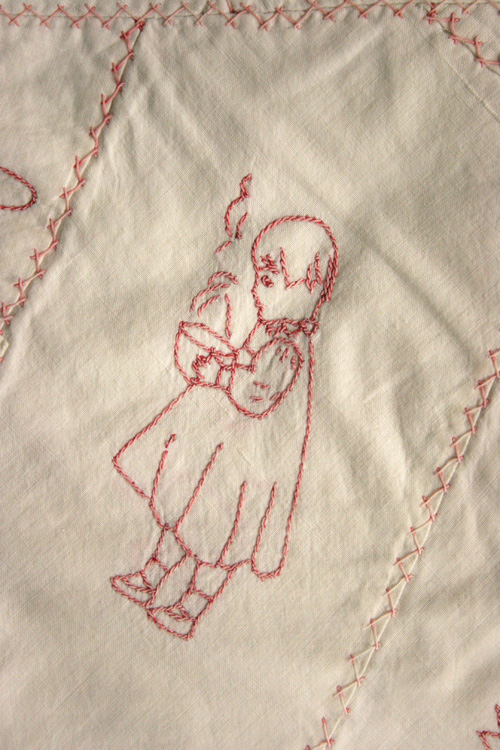
QUILT INDEX RECORD
12-8-7652
Who documented this quilt?
Michigan Quilt Project; Michigan State University Museum Collection
Where are the records for this quilt housed?
Michigan State University Museum
Michigan Quilt Project Number:
01.0245
If this quilt is owned by a museum, enter the accession number:
2001:160.4
Object label:
Holy Bible Coverlet
Maker unknown
Possibly made in Pennsylvania
c1892-95
Deborah Harding Redwork Collection, Michigan State University Museum, #2001:160.4
Essay:
The format of the "Holy Bible Coverlet" mimics a Crazy quilt, a style popular during the same period as Redwork. A Herringbone stitch, know during the late nineteenth century as a Featherstitch, creates the appearance of individual sections, thus creating the look of a Crazy quilt. In contrast to Redwork quilts that utilized one color, one fabric, and only a few stitches, Crazy quilts typically showcased a variety of decorative stitches on a range of fabrics including silks, satins, and velvets.
Rendered on the Bible in the quilt's center is a passage from Revelations 14:13: "Blessed Art the Dead, Which Die in the Lord." Does this passage imply the quilt was made as a memory quilt honoring someone who had died? An examination of the images depicted offer clues, but the quilt's provenance is not known.
Several of the quilt's embroidered designs reflect the ingenuity of its maker who used images found in advertisements for products such as Cuticura Soap, Imperial Granum, and Cod Liver Oil and probably tracings of items such as a teaspoon, keys, or a Bible.
By Mary Worrall, excerpted from Redwork: A Textile Tradition in America.
Redwork quilts became popular between 1885 and 1925 and are currently enjoying a revival at the beginning of the twenty-first century. They consist of images outline-embroidered with colorfast Turkey red cotton floss onto muslin squares intended for quilt blocks or household linens such as pillowcases, tidies, and splashers (cloths displayed in back of sinks or washstands). Popular designs included images inspired by Japanese designs; copies of Kate Greenaway's illustrations of children; animals, nursery rhymes; floral designs; Biblical scenes; and images commemorating historical events and figures.
Textle scholars believe that the 1876 Centennial Exposition in Philadelphia probably helped stimulate interest in both the technique and content of redwork. The exposition featured both a Japanese pavilion and a display organized by the Royal School of Needlework of Kensington, England. Styles of ornamental embroidery showcased at the exhibit became popular among American needleworkers and prompted a trend to make "art" needlework rather that just "plain sewing."
By Mary Worrall, excerpted from American Quilts from Michigan State University Museum.
Quilt's title:
Holy Bible Coverlet
Names for quilt's pattern in common use:
Redwork
If you are the quilt owner, how did you acquire this quilt?
Purchased the quilt
Time period:
1876-1900
When was the quilt started?
1892
When was the quilt finished?
1895
Quilt is presently used as:
Museum collection
This is a:
Finished quilt
How wide is the quilt?
71
How long is the quilt?
71
Shape of edge:
Straight
Shape of corners:
Straight
What color is the quilt?
Cream; Red
Overall color scheme:
Two color
Quilt's condition:
Good/moderate use
Type of inscription:
Initials
What is inscribed on the quilt?
L
Method used to make the inscription:
Embroidery
Location of inscription:
on block
Describe the quilt's layout:
Block pattern
Number of quilt blocks:
25
Size of quilt blocks:
14 1/2 x 14 1/2
Arrangement of quilt blocks:
Straight
Spacing of quilt blocks:
Side by side
Fiber types used to make the quilt top:
Cotton
Fabric styles used in the quilt top:
Solid/plain
Piecing techniques used to make the quilt top:
Hand Piecing
Can you feel or see paper on the quilt that was used as a construction aid?
no
Embellishment techniques used to make the quilt top:
Embroidery
Embellishments used:
Cotton thread
Materials used to make the back:
Cotton
Number of pieces of fabric in the quilt back:
3
Describe the back:
Same fabric used throughout
Materials used in the quilt binding:
Cotton
How is the binding made?
Bias grain
What is the width of the binding (measure on the top only)?
less than a half inch
How wide is the binding (measure on the top only)?
1/4
What kind of filling is used in the quilt?
No filling
How are the layers held together?
Not quilted
Where did the maker find their pattern?
Commercial/Published source: Book; Commercial/Published source: Magazine
Publications (including web sites) where this quilt or maker was featured:
Red and White: American Redwork Quilts and Patterns by Deborah Harding.
Person filling out this form is:
Quilt owner
Ownership of this quilt is:
Public- Michigan State University Museum
Quilt owner's name:
Michigan State University Museum
How was this quilt acquired?
Purchase
Describe anything about the history of the quilt that wasn't already recorded in a previous field:
Deborah Harding purchased this quilt from Virginia dealers who had found it in York, Pennsylvania.
Details
Access and copyright information:
Restricted
Who photographed this quilt?
Eifert
Copyright holder:
MSU Board of Trustees
Cite this Quilt
Holy Bible Coverlet. 1895. From Michigan State University Museum, Michigan Quilt Project; Michigan State University Museum Collection. Published in The Quilt Index, https://quiltindex.org/view/?type=fullrec&kid=12-8-7652. Accessed: 04/18/24
-
Exhibit
Redwork: A Textile Tradition in Americ...
Michigan State University Museum
-
Collection
Deborah Harding Redwork Collection
Worrall, Mary


